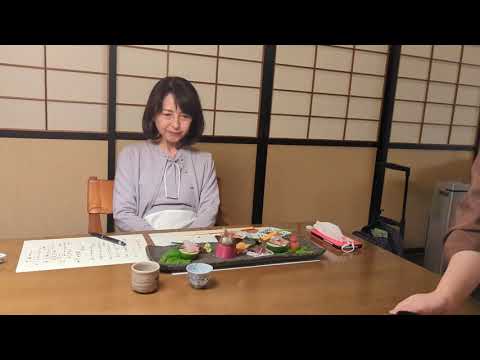We were served the second of two fabulous Kaiseki dinners in our room at Sanso Murata (山荘 無量塔), a luxury Onsen (hot springs) ryokan with just 12 rooms total, and located in the Yufuin area of Oita Prefecture on the Southern island of Kyushu, Japan. The menu, as well as explanation by the server, were all in Japanese, but I’ve tried my best to summarize each offering here. They are:
COURSE 1 – SAKIZUKE (先附 – Appetizers):
* Hiogi Gai no Nanokori Salad (ヒオウギガイの名残りサラダ – Butter Sauteed Noble Scallop with vegetables)
– Koshin Daikon (紅芯大根 – Watermelon Radish)
– Shimeji (占地 – Shimeji Mushrooms)
* Satsuma-imo Chips (薩摩芋チップス – Satsuma-imo Potato Chips)
* Beni-masu Kunsei (ニジマス燻製 – Smoked Rainbow Trout)
* Kabocha (南瓜 – Kabocha Japanese Squash)
– Sakura-jio (桜塩 – Pink Salt)
COURSE 2 – WAN (椀 – Soup Dish):
* Houbou Abura Shimo Kinome Usukuzu Shitate (魴鮄油霜木の芽仕立て – Spicy Red Gurnard with Kudzu Starch in thick soup)
– Warabi Tofu Sakura no ha Tsutsumi (蕨豆腐桜の葉包み – Eagle Fern Tofu wrapped in Sakura leaves)
– Myoga (茗荷 – Japanese Ginger)
– Urui (うるい – Hostas)
– Hoshin Daikon (紅芯大根 – Red Daikon Radish)
– Kinome (木の芽 – Young Leaves of a Sansho Plant)
DISH 3 – MUKOZUKE (向附 – Seasonal Sashimi):
* Haru Tomato (春トマト – Spring Tomato)
* Shima Aji Yaezukuri (縞鰺八重造里 – Striped Jack Sashimi Yaezukuri. Yaezukuri is a specific way a fish is cut, and is designed to give better texture and flavor, especially for tough-skinned (mainly silver skinned) fish)
* Hime Ninjin (姫人参 – Baby Carrots)
* Katsuo Tataki (鰹タタキ – Lightly Seared Bonito)
* Akagai Kanoko Tsukuri (赤貝鹿の子造里 – Ark Shell)
* Hojiso (穂紫蘇 – Shiso Flower)
* Isaki (伊佐木 – Chicken Grunt)
DISH 4 – NIMONO (煮物 – Simmered Dish):
* Tai to Wakatake Nabe (鯛と若筍鍋 – Red Sea Bream, Wakame Seaweed and Bamboo Shoots Hot Pot)
– Negi (葱 – Green Onions)
– Shintamanegi (新玉葱 – New White Onions)
– Kinome (木の芽 – Young Leaves of a Sansho Plant)
– Cresson (クレソン – Watercress)
COURSE 5 – SUNOMONO (酢の物 – Vinegared Dish):
* Kuruma-ebi to Hana Wasabi no Isobe Jule (車海老と花山葵、磯辺ジュレ – Japanese Tiger Prawn, Wasabi leaves and flower buds, and Nori Seaweed Jelly)
– Kuroma Ebi (車海老 – Japanese Tiger Prawn)
– Snap Endo (スナップエンドウ – Snap Peas)
– Nagaimo (長芋 – Chinese Yam / Japanese Mountain Yam)
– Fruits Tomato (フルーツトマト – Fruit Tomato)
* Kuruma Ebi Age Atama (車海老揚げ頭 – Deep-fried head of Japanese Tiger Prawn)
COURSE 6 – KAWARI BACHI (変鉢 – Replacement Dish, aka “deviation from the norm”):
FOR HIM:
* Oita Wagyu Gogun Morimi-yaki (大分和牛五草諸味焼き – Oita Wagyu Beef marinated with Moromi Miso Red Soybean Paste. Moromi Miso is made by fermenting and aging koji made from barley, soybeans, rice, etc. in salt water. It is made through the same manufacturing process as soy sauce, which is a little different from the so-called miso making method. In order to enjoy the texture of moromi, the ingredients are not crushed like normal miso, and the grainy barley remains as it is.)
– Jagaimo (じゃがいも – Potatoes)
– Soramame (蚕豆 – Small broad bean)
– Nasu (茄子 – Japanese Eggplant)
FOR HER:
* Oita Kanmuri Jidori no Sumibiyaki (おおいた冠地どり炭火焼 – Charcoal-grilled Kanmuri Chicken from Oita)
COURSE 7 – TOMEWAN (止椀 – Soup Dish):
* Aka Misoshiru (赤味噌汁 – Red Miso Soybean Paste Soup)
COURSE 8 – KOUNOMONO (香の物 – Pickled Vegetables):
* Kyuri Nukazuke (胡瓜糠漬け – Cucumber “Nukazuke” – Nukazuke is a type of Japanese preserved food, made by fermenting vegetables in rice bran (nuka), developed in the 17th century.)
* Konbu (昆布 – Konbu Seaweed)
* Bettara Daikon (べったら大根 – Sweet Daikon Radish pickles)
* Nozawana (野沢菜 – Japanese Mustard Leaves)
COURSE 9 – GOHAN (御飯 – Rice Dish):
* Niigata Koshihikari Hagama Gohan (新潟コシヒカリ羽釜ご飯 – Koshihikari Rice from Niigata cooked on an iron pot that’s shaped like it has wings on the side)
COURSE 10 – MIZUGASHI (水菓子 – Dessert):
* Fruits Zenzai to Ichigo Mousse (フルーツ善哉と苺ムース – Sweet Red Bean Soup with Fruits, and Strawberry Mousse below it)
– Ichigo (苺 – Strawberries)
– Ringo (林檎 – Apple)
– Orange (オレンジ)
– Matcha Shiratama (抹茶白玉 – Green Tea-flavored Glutonous Rice Balls. Shiratama is made with Shiratamako, a glutinous rice flour made from Japanese short-grain rice)
– Green Pea Mitsuni (グリーンピースの蜜煮 – Green Peas soaked in syrup)
* Vanilla Ice to Dried Sliced Orange (バニラアイスとドライスライスオレンジ – Vanilla Ice Cream with Dried Sliced Orange)


AloJapan.com